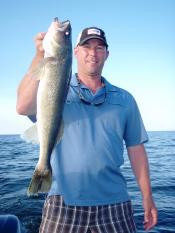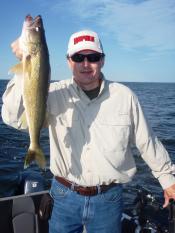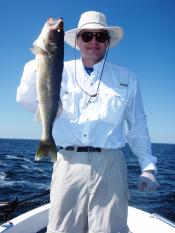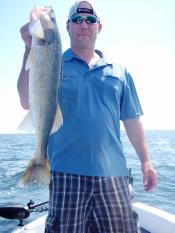 Things are literally heating up as the open water trolling bite enters July with high temperatures. Joining me on Mille Lacs for an open water/on the water trolling clinic were Tom Ryan, Tim Ryan and Gus Bergemann. All of these guys are experienced walleye anglers accustomed to catching walleyes via lindy rigs, spinner rigs and slip bobbers. They wanted to learn more about open water trolling so they could go back in their own boat, apply what they learned and achieve success. Topics covered included: trolling rods, line counter reels, braided and leadcore lines, planer boards, deep diving crankbaits, trolling patterns, scouting, proper rod placement, speed control, depth control, catching techniques, benefits of leadcore trolling and the little things that lead to success.
Things are literally heating up as the open water trolling bite enters July with high temperatures. Joining me on Mille Lacs for an open water/on the water trolling clinic were Tom Ryan, Tim Ryan and Gus Bergemann. All of these guys are experienced walleye anglers accustomed to catching walleyes via lindy rigs, spinner rigs and slip bobbers. They wanted to learn more about open water trolling so they could go back in their own boat, apply what they learned and achieve success. Topics covered included: trolling rods, line counter reels, braided and leadcore lines, planer boards, deep diving crankbaits, trolling patterns, scouting, proper rod placement, speed control, depth control, catching techniques, benefits of leadcore trolling and the little things that lead to success.
It was a memorable day on the water with light winds and great company. The walleyes however, were in a negative mood and finding a predictable pattern was challenging. Deep Thunderticks and Deep Tail Dancers took all of our fish and I can honestly say that colors didn’t matter much. We ended the day catching 21 walleyes and a few big ones over the 25 inch mark – a decent day but not the numbers that my boat was consistently producing.
 One of the most frequent questions I receive from fellow anglers is “How do you set up your open water leadcore rod and reels”. I will try and break it down:
One of the most frequent questions I receive from fellow anglers is “How do you set up your open water leadcore rod and reels”. I will try and break it down:
Leadcore Line: I use 18 lb leadcore line and I’ve good luck with Suffix. This line will sink about 5 feet for every color of leadcore (30 feet) when trolled at 2.0 m.p.h. Keep in mind, if you increase the strength of your leadcore line, (ie. 27 lbs) it doesn’t sink faster. It’s the same amount of lead inside the nylon sheath and only the nylon sheath is thicker. It actually sinks a little less because the thicker line has a bigger diameter. There’s a new Suffix 832 Leadcore Line out and the advantage is more sensitivity and it will sinks at a faster rate. Exact numbers are not known yet and I’m anxious to give this a try.
Leadcore Rods: I like to use a 8-9 foot leadcore trolling rod with a soft tip. This is just my personal preference and some guys go with shorties (5’) out the back of the boat. I like the feel of a longer trolling rod when it comes to fighting a bigger fish. It just gives more and allows you to absorb those big walleye head shakes. I like a medium heavy blank / moderate action or a medium power/moderate fast action. It’s important to find the right balance to hold the weight of the leadcore while trolling without overloading the blank.
 Leadcore Reel: I like to use a line counter reel for my leadcore setup. Is it absolutely necessary? No, since it’s easy to count the number of colors on your leadcore line (every 30 feet). However, I like to fine tune it or dial it in to the exact number on the LC reel each time I set out the line. It’s also important to buy a larger reel that will accommodate at least 6 colors (180) feet on the spool. This will ensure you can achieve a depth of 30 or more feet.
Leadcore Reel: I like to use a line counter reel for my leadcore setup. Is it absolutely necessary? No, since it’s easy to count the number of colors on your leadcore line (every 30 feet). However, I like to fine tune it or dial it in to the exact number on the LC reel each time I set out the line. It’s also important to buy a larger reel that will accommodate at least 6 colors (180) feet on the spool. This will ensure you can achieve a depth of 30 or more feet.
Leadcore Setup: I like to put on some cheap 20 lb mono backing and then add my leadcore line. Reason being is that it’s more economical and mono grips the spool a little better. The first thing you want to do is find out the line capacity of your reel in the 20 lb category. Now take the number of leadcore colors that you want to add to your reel and times it by 30 feet . Now minus that number from your reel capacity and it will represent the amount of mono you would want to put on your spool. For example, let’s say your reel holds 600 feet of 20lb test line and you want to have 6 colors (180 feet) of leadcore line on your spool. 600 minus 180 equals 420 feet of mono that needs to be added to your spool. Now reset your linecounter reel to zero and work backwards to 580 feet (the numbers will decrease because you’re putting line on and not taking it off). After you’ve added your mono backing, you will now want to tie on your leadcore line. Simply peel the nylon sheath back about 8 inches and separate it from the lead that’s inside. Break off the lead and straighten out the nylon sheath. Now tie a blood knot or a willis knot to attach the two lines together. There are some good videos on youtube that will show you how. Reset your line counter reel once again and now add your 6 colors of leadcore (180 feet) or until your line counter is full. It’s important to fill the spool otherwise your line counter may be off because it counts revolutions of your spool versus actual feet. If your spool is not full, your line counter may be reading 13, 14, 15 or higher inches per revolution versus 12 inches and you will be off a considerable percentage. If you don’t have a line counter reel, try and cut the leadcore line right after it changes colors. This will ensure you have a full color on your spool.
 After you’ve added your leadcore line, now it’s time to add a leader using the same blood knot or willis knot. A leader will help you from spooking fish. If you are typically fishing structure or dirty stained water that has a lot of debris in it, braid is probably the best way to go. Since there’s no stretch, you’ll be able to read the vibrations on your rod tip a little easier and know when you’re ticking the bottom or if you get any debris on your line. If you’re fishing clear water such as Mille Lacs and your targeting suspended walleyes, monofilament or fluorocarbon line may be a better choice which can help reduce the risk of spooking fish. The stretch in the line can also help when playing a bigger fish and absorb some of those head shakes. It’s simply more forgiving versus using braid. When I’m open water trolling on Mille Lacs, I usually fish with 50 foot mono or fluorocarbon leaders. Having a longer leader never hurts and there’s more benefits than disadvantages.
After you’ve added your leadcore line, now it’s time to add a leader using the same blood knot or willis knot. A leader will help you from spooking fish. If you are typically fishing structure or dirty stained water that has a lot of debris in it, braid is probably the best way to go. Since there’s no stretch, you’ll be able to read the vibrations on your rod tip a little easier and know when you’re ticking the bottom or if you get any debris on your line. If you’re fishing clear water such as Mille Lacs and your targeting suspended walleyes, monofilament or fluorocarbon line may be a better choice which can help reduce the risk of spooking fish. The stretch in the line can also help when playing a bigger fish and absorb some of those head shakes. It’s simply more forgiving versus using braid. When I’m open water trolling on Mille Lacs, I usually fish with 50 foot mono or fluorocarbon leaders. Having a longer leader never hurts and there’s more benefits than disadvantages.
There you have it – a leadcore setup that’s ready for open water trolling!
Now’s the time to get out there and try some open water trolling for walleyes. It’s a fun way to fish and it’s a consistent big walleye presentation. As always, I’m here to help so feel free to send me a PM or an email. For those of you that are interested in attending one of my open water / on the water trolling clinics – just let me know. I have a few spots left but they’re filling up fast.
Until next time – keep trollin’
Brad,
I respooled one of my line counter rods last weekend. I used 10# backing on the reel first. Before I put the lead core on I ran a little test. I measured off 25 ft with a tape measure. Then I had someone pull the line out (after zeroing the line counter) and the line counter repeatedly measured 50 ft! I then added three colors of 18# lead core along with a 50 ft 10# mono leader. I did the same test again. This time the leader measured 26 – 27 ft on my 25 foot test. The amount of line on the reel certainly makes a huge difference! Are you taking this offset in the reel counter reading into account when you’re dragging lead core to a specific depth? It seems to me to be the only way to get the bait to the depth that you’re targeting, especially when using a spinner bait that runs pretty flat.
Thanks
In most cases, the bigger spools that you use, the more accurate your line counters will read. Simply put – you’re able to put more line on your spool so your leadcore is only using the back ½ or 1/3 of the spool. That’s why I use big reels like the Shimano Tekota 600s. Another good way to check your linecounter reels when you’re on the water is to attach a clip on line counter(Berkely makes one). They actually count feet and it’s a great little tool to have in your boat to see if you’re line counters are reading accurately and it can help you get it dialed in.
Brad,
I used those same clip on line counters several years ago fishing for Whitefish in Canada (we got tired of catching walleyes). We were fishing a 2 – 3 foot layer of fish, 45 feet down in 50 ft of water. We tested several of these and found some of them to read at least 20 – 25 feet off in 50 feet of water. That’s why we switched to reels with the built in line counters. Have the clip on units gotten any better in accuracy? I’m not looking for inch accuracy, but 1 foot accuracy in 25 feet shouldn’t be unreasonable. I might buy one and try the same test as I did before to see if they are better today.
Thanks for your help. By the way, I’ll be fishing with you on Sunday 7/22. Looking forward to it.
I seem to buy two of everything when it comes to fishing, so when I bought new leadcore trolling reels I basically set one up backwards and then cranked that onto another reel and repeated onto the first one. On reel 1 I put on a 50′ leader of mono (I measure the 50′ with a tape measure), crank on as much leadcore as you want, and then put your mono backing on. I put enough mono backing on until I get an accurate reading at 100 feet (this takes a few times of measuring with the tape). I then cut the line off the filler spool and tie the backing to reel 2. I zero out reel 2 and start reeling in the line off of reel 1. I make a note of the linecounter reading when I get all the backing on to the Reel 2. I can use this when I set up reel 1. I reel the rest of the leadcore line and mono leader onto Reel 2 and the reel is fully spooled. To repeast on reel 1, zero out the reel and start reeling in the backing. Once I get to the same reading I had on Reel 2, I tie on the leadcore and put on the same amount of leadcore. Now I add my 50′ leader and both reels should be the same. I am going to be adding a few new leadcore setups so I will probably be doing this again tonight. I retie leaders quite a bit, so I marked out 50′ and 100′ in my yard.
Great report jam-packed with information per-usual Brad. It’s obvious you know your trade well, and do a good job teaching it to others. Happy clients and smiles all around!
Joel
Great Info , Brad,I also have checked my line counters, some are on some are off by 10′
Nice work (again) Brad. I did want to add that I have three lengths of rods that I use for lead – 6’6″, 8’6″ and 12′ depending on the scenario – I use the 6’6″ + 12′ when I am running 4 lead lines at once and the 8’6″ when I am only running lines right off the boat. Can seem like overkill but when the fish tell you all they want is lead for the day having a system to pull four lines at once effectively definitely pays dividends! In my opinion you only need 5 reels spooled with lead: 4 to run when conditions are right an one for a back up when Murphy strikes…
Good luck out there!
-ted
Way to go, Brad! As usual, a great and informative report.
Great report Brad!
Brad,
great load of info in your report.. I too am an amature when it comes to open water trolling as I spend a lot of my time on the river is SW Wi.
With trolling either lead core or just straight braid….. what would be the #1 thing you would say to watch out for… as I always learn the hard way… trying to keep myself from tangles, lost cranks and what ever else could happen…
thanks in advance
Great info Brad,
and I also liked Bigfifes thoughts with doing 2 reels and duplicating it on reel 2.
thanks again
Jack
I believe the most important factor is knowing the depth curves of your crankbaits and being able to place them at the desired depth (2-4 feet above the arcs on your sonar) and understanding the trolling variances amongst braid and leadcore lines. In other words, it doesn’t matter what style crankbait you have on, what color you choose and what speed your trolling if you’re not in the strike zone.
Brad, great report and some good info you are giving us. Thanks!! As someone else mentioned your last few reports have been filled with helpful info and I have them saved on my phone for reference! Still working on finding time to attend one of your clinics….
I am curious…when running the 50′ leader I assume you just add [to the lead core depth based on 5’/color] the diving depth for that particular lure based on the dive chart at 50′ for the given line you are using? Or is there some fudge factor involved.
I assume the lead core will run the 5’/color for most the lures you use, or do some lure actually make the lead run deeper than others (at 2 mph)?
You need to account for the depth curve of your crankbait for your leader. However, based on my experience I feel that it’s not 100% and more like 80-90% of your depth curve because you have a bow in your leadcore line.
I feel the sink of your leadcore line is about the same, regardless of which crankbait you are using. You may gain a foot or so with a deep diving crankbait but not a lot. Keep in mind, your leadcore line moves around a lot back there from side to side as your boat turns and up and down as you encounter waves. Leadcore is very speed sensitive and it snakes around back there as it follows the path of your boat.